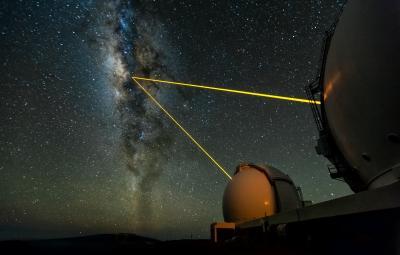Black holes, which form out of the collapse of matter, have such high density that nothing can escape their gravitational pull, not even light. They cannot be seen directly, but their influence on nearby stars is visible and provides a signature. Einstein's theory of general relativity predicts that mass distorts space and time and therefore not only slows down the flow of time but also stretches or shrinks distances.
Before this discovery, astronomers knew of only one star with a very short orbit near the black hole: S0-2, with an orbit of 16 years. The "S" is for Sagittarius, the constellation containing the galactic center and the black hole.

W. M. Keck Telescopes on Mauna Kea, Hawaii, observing the galactic center. The lasers are used to create an artificial star in the Earth's upper atmosphere, which is then used to measure the blurring effects of the lower atmosphere (the effect that makes the stars twinkle in the night sky). The blurring gets corrected in real time with the help of a deformable mirror. This is the adaptive optics technique. Credit: Ethan Tweedie
"I'm extremely pleased to find two stars that orbit our galaxy's supermassive black hole in much less than a human lifetime," said Andrea Ghez, leader of the discovery team and a UCLA professor of physics and astronomy. Most of the stars have orbits of 60 years or longer, she said. "It is the tango of S0-102 and S0-2 that will reveal the true geometry of space and time near a black hole for the first time. This measurement cannot be done with one star alone."
"Today, Einstein is in every iPhone, because the GPS system would not work without his theory," said Leo Meyer, lead author of the study. "What we want to find out is, would your phone also work so close to a black hole? The newly discovered star puts us in a position to answer that question in the future."
"The fact that we can find stars that are so close to the black hole is phenomenal," said Ghez. "Now it's a whole new ballgame, in terms of the kinds of experiments we can do to understand how black holes grow over time, the role supermassive black holes play in the center of galaxies, and whether Einstein's theory of general relativity is valid near a black hole, where this theory has never been tested before. It's exciting to now have a means to open up this window. This should not be a neighborhood where stars feel particularly welcome,. But surprisingly, it seems that black holes are not as hostile to stars as was previously speculated."
Over the past 17 years, Ghez and colleagues have used the W.M. Keck Observatory, which sits atop Hawaii's dormant Mauna Kea volcano, to image the galactic center at the highest angular resolution possible. They use a powerful technology, which Ghez helped to pioneer, called adaptive optics to correct the distorting effects of the Earth's atmosphere in real time. With adaptive optics at the Keck Observatory, Ghez and her colleagues have revealed many surprises about the environments surrounding supermassive black holes, discovering, for example, young stars where none were expected and seeing a lack of old stars where many were anticipated.
"The Keck Observatory has been the leader in adaptive optics for more than a decade and has enabled us to achieve tremendous progress in correcting the distorting effects of the Earth's atmosphere with high–angular resolution imaging," Ghez said. "It's really exciting to have access to the world's largest and best telescope. It is why I came to UCLA and why I stay at UCLA."
In the same way that planets orbit around the sun, S0-102 and S0-2 are each in an elliptical orbit around the galaxy's central black hole. The planetary motion in our solar system was the ultimate test for Newton's gravitational theory 300 years ago; the motion of S0-102 and S0-2, Ghez said, will be the ultimate test for Einstein's theory of general relativity, which describes gravity as a consequence of the curvature of space and time.
"The exciting thing about seeing stars go through their complete orbit is not only that you can prove that a black hole exists but you have the first opportunity to test fundamental physics using the motions of these stars," Ghez said. "Showing that it goes around in an ellipse provides the mass of the supermassive black hole, but if we can improve the precision of the measurements, we can see deviations from a perfect ellipse — which is the signature of general relativity."
As the stars come to their closest approach, their motion will be affected by the curvature of spacetime, and the light traveling from the stars to us will be distorted, Ghez said.
S0-2, which is 15 times brighter than S0-102, will go through its closest approach to the black hole in 2018.
The deviation from a perfect ellipse is very small and requires extremely precise measurements. Over the last 15 years, Ghez and her colleagues have dramatically improved their ability to make these measurements.
Published in Science.





Comments